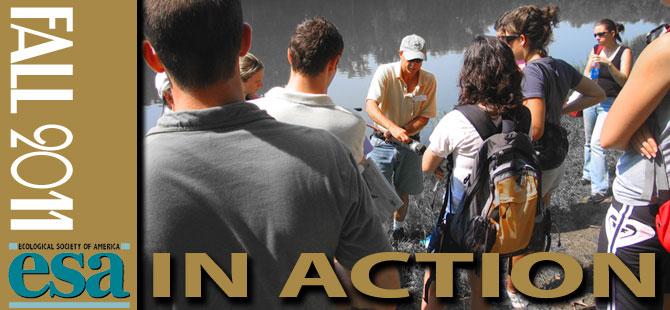
INFORMING POLICY WITH SCIENCE
CONGRESSIONAL BRIEFINGS
ESA Sponsors Congressional Briefing on Flood Management
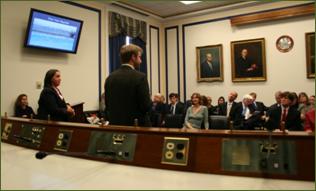 |
ESA File Photo: Stanley and Opperman interact with congressional briefing attendees. |
The speakers addressed the function of rivers and floodplains and the need to manage rivers as systems and for multiple benefits. They highlighted the potential for green infrastructure solutions, which would restore floodplains to help reduce risk to people and infrastructure and generate such benefits as increased fish production.
ESA Cosponsors Congressional Briefing on Mercury
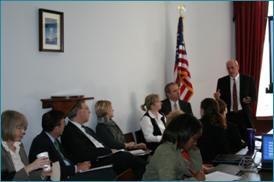 |
ESA File Photo: Driscoll answers questions about mercury pollution. |
CORRESPONDENCE TO LAWMAKERS
Algal Bloom Control Policy
In November, ESA alerted targeted congressional staff to a paper published in one of the Society's scientific journals, Ecological Applications, which is relevant to a recent Senate Commerce, Science and Transportation Committee bill, the Harmful Algal Blooms and Hypoxia Research and Control Amendments Act of 2011. The paper, "Estimating cyanobacterial bloom transport by coupling remotely sensed imagery and a hydrodynamic model" is by Timothy T. Wynne and other colleagues with the National Oceanic and Atmospheric Administration.
Preserving Investment in NSF, R&D
In October, a group of 70 scientific societies, including the Ecological Society of America, joined together in sending a letter to the Select Joint Committee on Deficit Reduction committee highlighting the major contributions of scientific research to American society. Noting that 50 percent of economic growth over the last century has come from advancements in science and technology, the societies requested that the committee support continued investment in federal research. "Indeed, the bipartisan Simpson-Bowles Debt Commission last year identified federal research and development (R&D) as an area of U.S. investment too critical to be cut. We urge you to entertain a similar conclusion," the letter stated. ESA also joined other scientific societies in signing a letter to the committee urging it to support food and agricultural research.
In September, ESA teamed-up with the American Institute of Biological Sciences to encourage members of the biological community to contact their Senators and request funding be restored to the National Science Foundation (NSF). The action alerted was prompted by the Senate Appropriations Committee's cut to NSF research directorates by nearly $121 million for Fiscal Year (FY) 2012 while the House Appropriations Committee voted for a $43 million increase. Congress subsequently agreed to a $173 million increase for NSF.
ESA also supported a multi-organizational letter to Congress to preserve funding for the Environmental Protection Agency's Office of Environmental Education. The U.S. House of Representatives has sought to eliminate funding for the program in FY 2012.
ESA's new handbook, "An Ecologist's Guidebook to Policy Engagement" is available as an e-book or print copy. Released during ESA's 2011 Annual Meeting, the booklet provides advice and resources for engaging with decision makers at various levels of government. It also includes overviews of environmental laws, federal agencies, and tips on effective communication. To order as an e-book or print copy, please go to the ESA eStore . |
ESA MEMBERS IN ACTION
 |
Claire O'Dea |
In his capacity as Science Advisor to the Director at the Bureau of Ocean Energy Management in the Department of Interior (DOI), ALAN D. THORNHILL serves as the principle representative for DOI on the U.S. Global Change Research Program, the Ocean Resource Management Interagency Policy Committee, and the Interagency Arctic Research Policy Committee. He also led the writing team that developed the DOI-wide policy on scientific integrity—making DOI the first federal agency to meet the requirements of the Presidential Memorandum on Scientific Integrity.
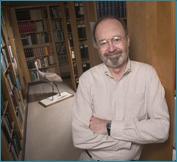 |
Stanley Temple |
JENNIFER MOSLEMI is a co-founder of Habitat Seven, a media lab comprised of biologists and web multimedia developers, to create digital communication tools for scientists. Habitat Seven works with ecologists at academic and non-profit organizations to create websites, videos, mobile apps, and social media campaigns to help give science a media presence.
JONATHAN FOLEY (University of Wisconsin, Madison) participated in a World Wildlife Fund symposium in Washington, DC that focused on the future direction of global conservation efforts. The two-day symposium, "Conservation Forward: Ideas That Work and How Science Can Effect Change," brought together conservation leaders from around the world in a discussion focusing on new ideas and scientific innovations in the areas of energy, agriculture and climate change.
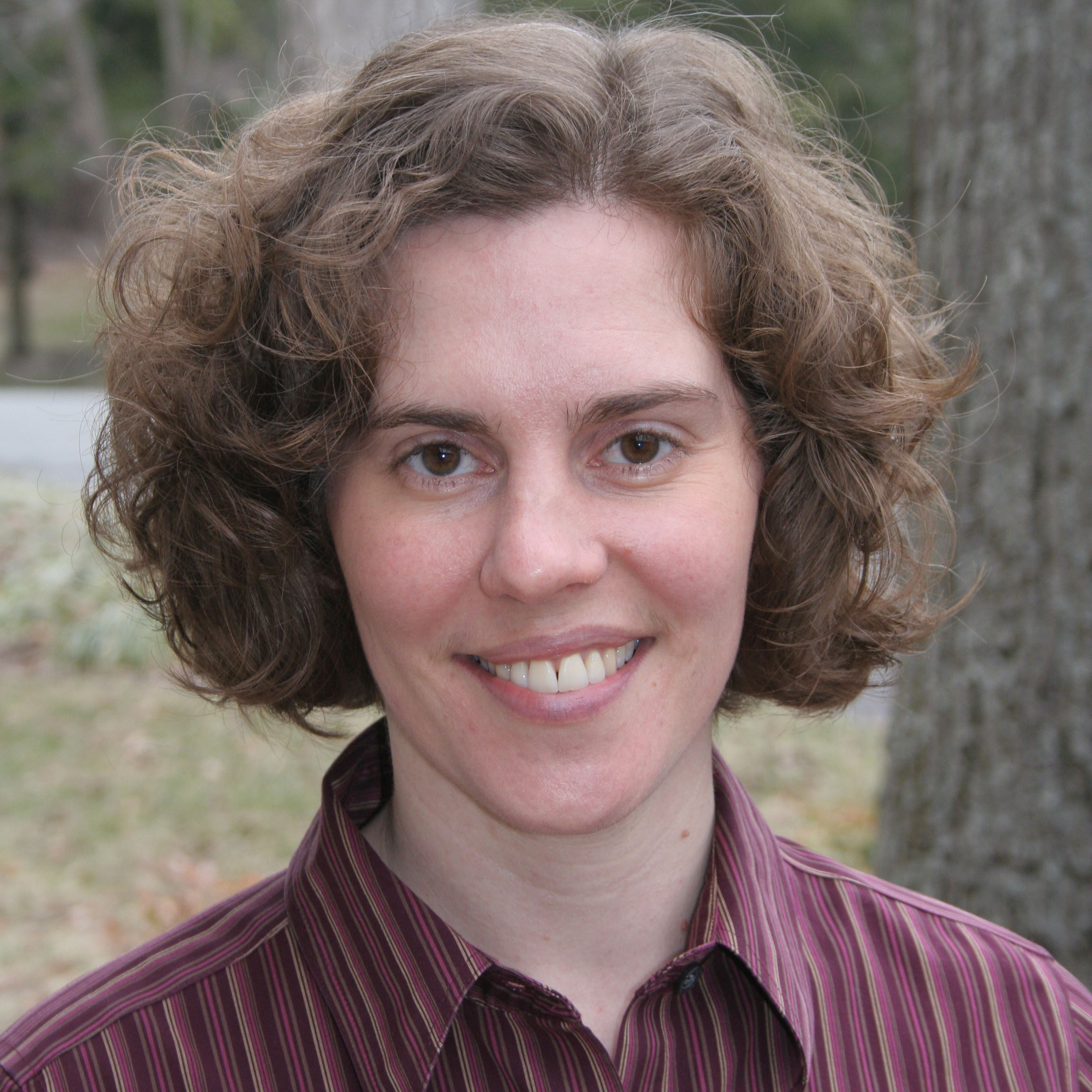 |
Ariana Sutton-Grier |
ESA WANTS TO HEAR FROM YOU!ESA is interested in highlighting policy, media or other member activities that share ecological information beyond the ecological community. Please send updates to ESA's Public Affairs Office at pao@esa.org. |
Highlights from the 2011 ESA Annual MeetingThe Society's 96th Annual Meeting held this year in Austin, Texas, drew nearly 3,700 attendees from across the country and the globe. Highlights included field trips, awards, an Opening Plenary Panel discussion on the meeting's theme of Earth stewardship, a MacArthur Lecture by Stephen Pacala, and numerous symposia, oral and poster presentations ranging from warfare ecology to natural history to bat conservation. In honor of Austin's famous music scene, ESA hosted An Austin Night for Nature, a live concert featuring local musicians. Open to the public, the concert benefited local environmental groups. National and international media coverage included stories in Science, Nature, ScienceDaily, HealthDay, and Voice of America among many others. View photos of ESA 2011 Awards and Austin Night for Nature on ESA's Facebook page.
|
SEEDS Field Trip
 ESA's SEEDS Program (Strategies for Ecology Education, Diversity and Sustainability) held a field trip in October in New Mexico at the Jornada Basin Long Term Ecological Research (LTER) site. Twenty two undergraduate students from 18 colleges and universities participated in the trip which featured the unique history of the Jornada LTER and how it informs arid land management.
ESA's SEEDS Program (Strategies for Ecology Education, Diversity and Sustainability) held a field trip in October in New Mexico at the Jornada Basin Long Term Ecological Research (LTER) site. Twenty two undergraduate students from 18 colleges and universities participated in the trip which featured the unique history of the Jornada LTER and how it informs arid land management.
MEDIA
NEW ISSUES IN ECOLOGY EXAMINES AIR POLLUTION
The Ecological Society of America has published the 14th edition of its Issues in Ecology series. In "Setting Limits: Using Air Pollution Thresholds to Protect and Restore U.S. Ecosystems," lead author Mark Fenn (U.S. Forest Service) and nine colleagues review current pollution evaluation criteria. The authors propose science-based strategies to set new limits and mitigate acid rain, algal blooms, and accumulation of toxic mercury in plants and animals.
EcoToneESA is always looking for new guest contributors to ESA's popular blog, EcoTone, which features ecology and its connections to public policy and society. Contact ESA Communications Officer Liza Lester to learn more about contributing a post: llester@esa.org. |
'Follow' ESA activities on Twitter, FacebookKeep track of opportunities and updates of ESA through our Facebook page and twitter. |
